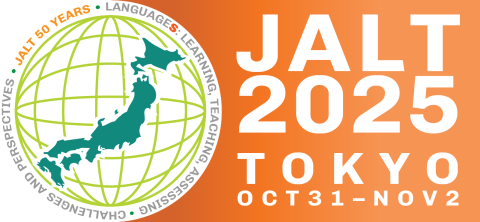JALT2025 Postconference Publication
LanguageS: Learning, Teaching, Assessing – JALT 50 Years – Challenges and Perspectives
Submission Guidelines
Mission Statement
The annual JALT Postconference Publication (PCP) serves as a permanent record of research and teaching practices presented at the JALT International Conference. Its purpose is to highlight work that is both practical and insightful for current and future educators in Japan and beyond. Submissions are expected to demonstrate academic rigor, originality, and relevance to the field of language education. All manuscripts must follow APA 7th Edition guidelines.
Call for Submissions
All noncommercial presenters at JALT2025 are cordially invited to submit a paper based on their presentation for publication in the official 2025 Postconference Publication, LanguageS: Learning, Teaching, Assessing – JALT 50 Years – Challenges and Perspectives. Please note that due to the large number of submissions received every year, your paper may not finish review until June or July. To help expedite the process, we ask that all authors also sign up to review at least one other paper under consideration with the PCP.
Please review the submission checklist below:
Deadline for Submission: Sunday, January 11, 2026 11:59PM
Submissions can be made from Tuesday, November 4, 2025. All papers must be submitted by 11:59PM Japan Standard Time, Sunday, January 11, 2026. Submissions after that date will not be considered.
Downloadable Files
Please download the template file to help you write your manuscript. We recommend that you rename one copy as Blinded_[Manuscript Title] and edit this document for your submission file. You can download the template again to use as a reference as you replace the template text with your own. Please remember that you will need to properly anonymize your blinded submission files. Do not include your name in any part of the blinded manuscript or supplementary files. [PCP Template Document] [PCP Template PDF]
Please note that all papers go through a rigorous review process, and submission does not guarantee acceptance. Authors are responsible for completing all of the following stages promptly and maintaining communication with editors.
- Initial Review (editors check)
- Double-blinded Review (sent to reviewers)
- Revisions
- Copyediting
- Layout
Please note that papers may be rejected at any stage if they fail to meet publication standards, violate ethical guidelines, or if authors do not cooperate with editors or respond to messages in a timely manner.
Online Submissions オンラインでの投稿
To start your submission, please go to our submission site.
If you do NOT have an account in our system, follow these steps:
- Visit http://jalt-publications.org/content/.
- Select REGISTER in the top right corner.
- Complete the personal information.
- Click REGISTER.
- Select Postconference Publication. You will see a MAKE A SUBMISSION link on the right. Follow the steps.
- Follow the steps to complete your submission.
- You can check on the progress of your review and on the editing process through your author page in the journal.
If you already have an account registered in the system, follow these steps:
- Visit http://jalt-publications.org/content/.
- Log in.
- Select Postconference Publication. You will see a MAKE A SUBMISSION link on the right.
- Follow the steps to complete your submission.
- You can check on the progress of your review through your author page in the journal.
Professional Conduct and Communication
Unprofessional or discourteous communication with editors or volunteers may result in the submission being removed from consideration. The Postconference Publication is managed entirely by volunteers who dedicate their time to helping authors improve their work. Please maintain respectful and professional communication throughout all stages of the process. Authors who do not cooperate with editors or miss repeated deadlines without notice may have their submissions withdrawn.
Restrictions and Eligibility
- Only authors who presented at the JALT International Conference are eligible to submit.
- Only one paper per presentation may be submitted.
- For forums and colloquia, multiple papers may be considered with prior consultation.
- Commercially sponsored presentations are generally not accepted unless the content is pedagogically focused and pre-approved by the editors.
- Submissions must be original and not under review elsewhere. Plagiarism or self-plagiarism will result in rejection and may lead to a publication ban across all JALT Publications.
Manuscript Requirements
- Upload manuscripts in .doc or .docx format only (no PDFs).
- Ensure the paper is fully anonymized before submission.
- Include English and Japanese abstracts (authors are responsible for translation accuracy).
- Clearly label and upload original figures and charts (Excel, JPG, or PNG formats).
- Papers using human participant data must include a statement confirming informed consent and institutional approval.
- Authors are responsible for verifying APA 7th Edition reference formatting, including DOIs where available.
Contact Information
For general inquiries, please note that the official PCP email address (jaltpubs.pcp.ed(@)jalt.org) receives a high volume of spam which may make it difficult to locate important messages. For serious or time-sensitive inquiries, please contact the Editor-in-Chief directly at blacy.jalt(@)gmail.com.
We are always looking for volunteers to help us with reviews, content editing, and copyediting. If you would like to contribute to the publication in this capacity, please feel free to reach out to us via email.
We look forward to collaborating with this year’s authors and volunteers to create another outstanding volume of the JALT Postconference Publication!


